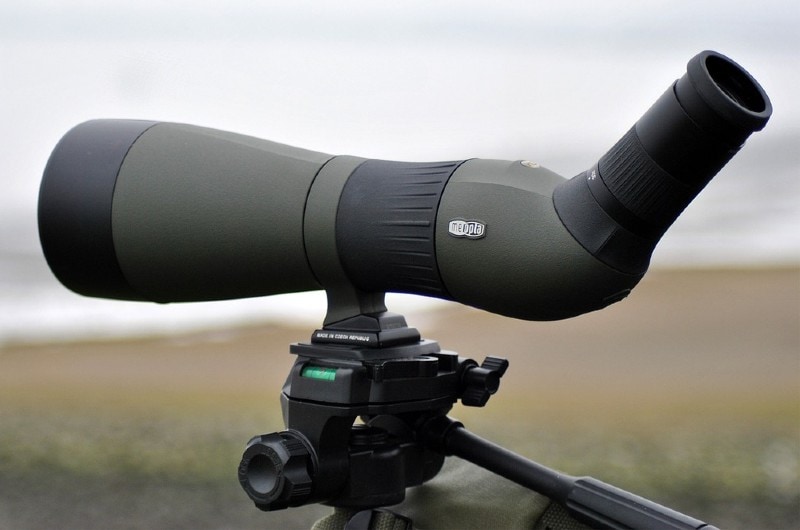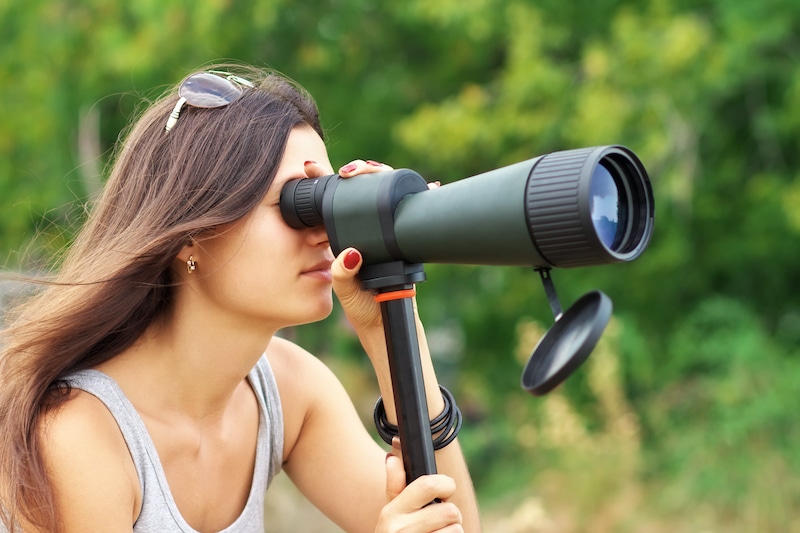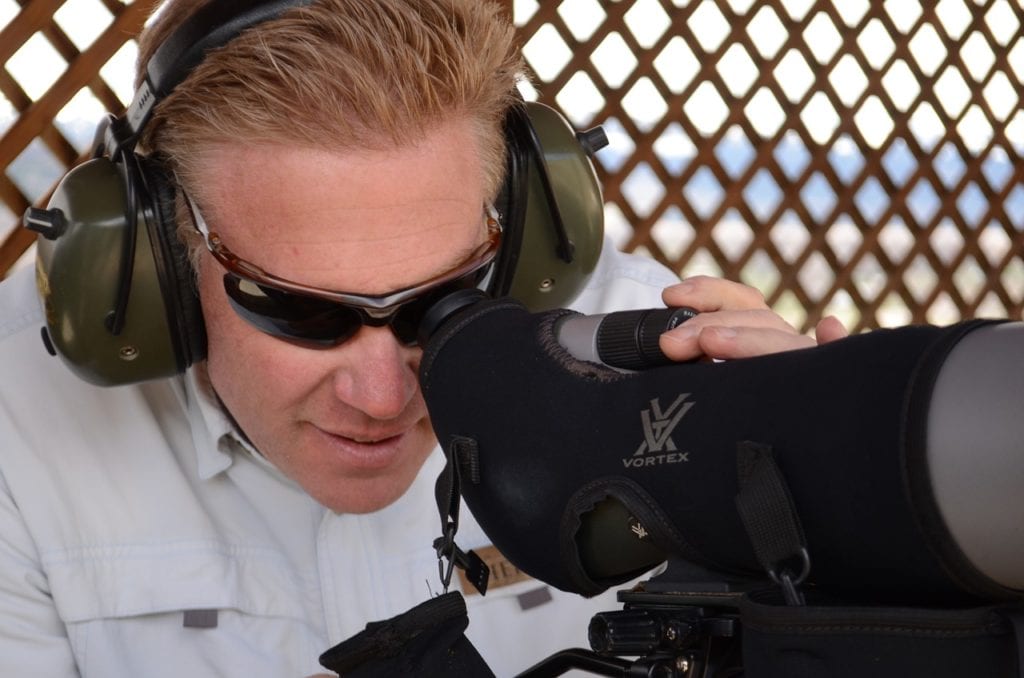What Is a Spotting Scope & What Are Its Uses?
Last Updated on

Humans have created several amazing devices over the centuries to see far-away things up close. The magnifying glass was first, followed by the telescope, binoculars, the magnifying glass, observatories, and space-based telescopes. Another very similar device is the spotting scope. Widely known among hunters and wildlife photographers, a spotting scope is, at its core, a telescope. However, as the name suggests, the spotting scope is used to spot things, often while using another device, including a rifle, gun, camera, and even binoculars.
One difference between spotting scopes and telescopes is the eyepiece, which is usually quite large to make them easier to use. Some scopes come attached to another device, like the spotting scope on a rifle. Other spotting scopes are detached and used like a telescope, although most folks use a tripod to stabilize the view. If you would like to discover more about spotting scopes, read on!

How Does It Work?
Like a telescope, binoculars, or magnifying lens, a spotting scope magnifies an object far away so you can see it clearly. Many spotting scopes are relatively small, so they can be attached to another device, like a camera or rifle. Some spotting scopes, however, are much larger and need to be supported by a tripod.
Inside the spotting scope are a series of lenses and a prism system. The lenses magnify the image so that it appears larger. The prisms rotate the image so that what you see in the eyepiece is right side up and not upside down. Also, the magnification on spotting scopes can be changed with the eyepiece, making them easy to use and focus on a subject.
You look through the sighting tube at an image when using a spotting scope. Light enters the scope through a convex lens, is reflected off a mirror, and can be seen in the viewing tube. However, since it’s upside-down, another convex lens inverts the image one last time so that, in the eyepiece, you see it right side up. There are millions of combinations of lenses, prisms, and mirrors that can be used to create a spotting scope.

What Are the Types of Spotting Scopes?
Spotting scopes don’t come in a wide range of types like some optical instruments. There are basically two types of spotting scopes: a mono-ocular spotting scope and a bi-ocular spotting scope. There are only a few differences between the two, and some are quite subtle.
Mono-ocular Spotting Scopes
A mono-ocular spotting scope (which is by far the most popular type) has a 90-degree angle for the eyes, and you use one eye to use it. Mono-ocular spotting scopes are typically found on rifles or used by hand to watch wildlife or sporting events. Ironically, a mono-ocular spotting scope works best with bifocals.
Bi-Ocular Spotting Scopes
A bi-ocular spotting scope is more like a pair of binoculars, not surprisingly, and lets you use both eyes by setting the angle slightly less than 90 degrees. Bi-ocular spotting scopes are popular with people who wear glasses since they are more comfortable. Since they’re heavier, bi-ocular spotting scopes are usually used with a tripod for support.
Straight SpottingScopes
Straight spotting scopes are usually mono-ocular and meant to be used with one eye. Straight spotting scopes use a one-piece lens and eyepiece setup. That makes them smaller and easier to carry, which is why they’re so popular, especially for hunting. Many of the best, most accurate rifles have a high-quality, straight, bi-ocular spotting scope attached to them.
Angled Spotting Scopes
Angled spotting scopes allow the user to assume a more relaxed position when using the spotting scope as the eyepiece is angled up towards their eyes. Many photographers use angled spotting scopes because they offer a wider field of view and, for people with glasses, are more comfortable and less stressful on their eyes. Angled spotting scopes are typically bi-ocular and thus heavier, requiring a tripod.

Where Is It Used?
Spotting scopes are used in several situations and activities. For example, hunters use spotting scopes to spot their prey when hunting to get the perfect shot. Photographers also use spotting scopes to spot their subjects, which can include the stars and planets, wildlife, celebrities, and more. Birdwatchers use spotting scopes to detect birds in the wild quickly, and spotting scopes can also be sued by land surveyors when performing their job. You’ll often see spotting scopes at sporting events, including tennis, golf, soccer, and football. The smallest spotting scopes will fit in a jacket pocket and are very popular magnification devices when traveling, hiking, and biking.

Advantages of Spotting Scopes
Most binoculars have a magnification range between 4x and 30x, which, while good, isn’t great, especially if you’re hunting game or shooting photographs. Most spotting scopes start at 11x and can go to 60, 80, and even 100x, to magnify objects from significantly farther away. They also have adjustable power optics that allow you to zoom in on a subject and back out quickly.
Small mono-ocular spotting scopes are more portable and are ideal for shooting at a rifle range but also excellent for spotting stars and planets, birdwatching, and hunting. Both small and large spotting scopes work very well in low-light conditions. Bi-ocular spotting scopes also let you look with both eyes, which some people like more than using one eye (especially those with glasses).
Disadvantages of Spotting Scopes
The most significant disadvantage of small, monocular spotting scopes is that you can only use one eye to look through them, which some people don’t like. Another disadvantage comes with large, bi-ocular spotting scopes, which are much heavier and bulkier and need a tripod for stability. In other words, they aren’t what you’d call “portable” and usually require a carrying case when transported.
Also, the setup time for a spotting scope can take a few minutes, by which time your subject might have flown, run, or swam away. Some aren’t waterproof, and the image stability at higher magnifications with a spotting scope can be sketchy at times. Lastly, high-quality spotting scopes usually cost more than binoculars, and if you have a big, bi-ocular scope, you’ll spend more on accessories like a tripod, carrying case, etc.

Frequently Asked Questions (FAQs)
What is the typical magnification for a spotting scope?
The most commonly used magnification for a spotting scope is 30x, but you can find them in the range between 15x to 60x.
What do the numbers on a spotting scope signify?
Just like with a pair of binoculars, the two numbers on a spotting scope identify the magnification of the scope and the diameter of its lens in millimeters. Therefore, a 10×30 spotting scope will have a magnification of 10x and a lens diameter of 30 millimeters.
What is the main advantage of using a spotting scope?
Most people who use spotting scopes will tell you that the main advantage is finding an object using low magnification and then increasing to higher magnification to see it much more clearly.
Is a tripod always needed with a spotting scope?
Mono-ocular spotting scopes are typically small and made to be attached to a rifle, camera, or another device. This type of spotting scope usually doesn’t need a tripod. Larger bi-ocular spotting scopes, however, can be rather heavy and hard to focus due to movement. That’s why they typically require a tripod.
What do the letters HD and ED stand for on a spotting scope?
The letters HD, as on many electronic devices, stands for High Definition. The letters ED stand for Extra-low Dispersion glass, which gives you a much clearer view of what you’re looking at.
Which accessories are needed with a spotting scope?
A small, mono-ocular spotting scope needs few, if any, accessories (maybe a small carrying case. Larger bi-ocular spotting scopes, however, usually need a tripod and a carrying case.
What factor is most important in a high-quality spotting scope?
The objective lens size. The bigger the objective lens, the more light will enter and the more clearly you’ll see your subject.
A Quick Reference Guide
| When to Use a Straight Spotting Scope | When to Use an Angled Spotting Scope |
| When hunting wild game with a rifle | When looking at wildlife or other objects very far away |
| When at a ball game or sporting event | When photographing wildlife |
| When you need a portable spotting scope | For looking at the stars and planets |
| When you need a spotting scope that you can use quickly | To give your eyes and back a break |
| When you want an affordable spotting scope | When you need a motionless scope to see objects sharply |

Summing Up
When you need a device that’s stronger than a pair of binoculars and empowers you to see an object in low-light situations, a spotting scope is perfect. Spotting scopes usually have a much higher magnification power than binoculars, especially larger, angled spotting scopes. They allow you to find objects fast, even if they’re moving and then zoom in quickly to see them in great detail. Smaller spotting scopes are easy to transport and use at fun events, while larger spotting scopes need a tripod for stability.
Hopefully, all of your questions have been answered, and you know the spotting scope you’re going to purchase.
- You might also like: Can Loons Walk on Land? Is It Normal?
Featured Image Credit By: leenheer, Pixabay
Table of Contents
- How Does It Work?
- What Are the Types of Spotting Scopes?
- Where Is It Used?
- Advantages of Spotting Scopes
- Disadvantages of Spotting Scopes
- Frequently Asked Questions (FAQs)
- What is the typical magnification for a spotting scope?
- What do the numbers on a spotting scope signify?
- What is the main advantage of using a spotting scope?
- Is a tripod always needed with a spotting scope?
- What do the letters HD and ED stand for on a spotting scope?
- Which accessories are needed with a spotting scope?
- What factor is most important in a high-quality spotting scope?
- A Quick Reference Guide
- Summing Up
About the Author Greg Iacono
Greg Iacono is a self-taught writer and former chiropractor who, ironically, retired early due to back problems. He now spends his time writing scintillating content on a wide variety of subjects. Greg is also a well-known video script writer known for his ability to take a complex subject and make it accessible for the layperson.
Related Articles:
Binocular Magnification Chart: Numbers & Distances Compared
What Is the Best Binocular Magnification for Hunting? Optical Features Explained
When Were Binoculars Invented? History, Today & Future
How to Clean a Refractor Telescope: Step-by-Step Guide
How to Clean a Telescope Eyepiece: Step-by-Step Guide
How to Clean a Rifle Scope: 8 Expert Tips
Monocular vs Telescope: Differences Explained (With Pictures)
What Is a Monocular Used For? 8 Common Functions
